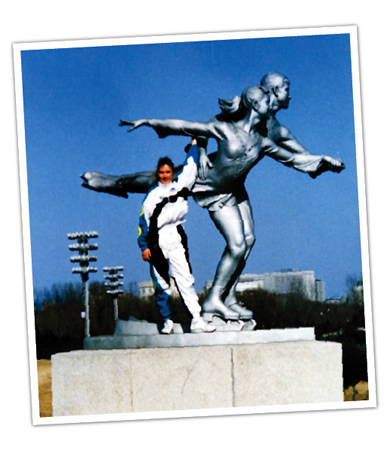 |
Posing in front of a skating monument in North Korea |
| |
What was your introduction the sport?
My mother first introduced me to the sport of ice skating when I was around 8 years old. My brother was playing ice hockey at the time, and a son of my friend had taken it up so my mum thought it might be nice for me to give it a try.
My first skate was not far from home at the St. Moritz Ice Rink in St.Kilda. I appeared to have some natural ability. So afterwards, mum asked me if I would be interested in taking lessons. Funnily enough I said “no”. I had already taken one ballet class at the time, and really thought I wanted to be a dancer instead. Looking back now, I am so glad she made me take up ice skating instead.
What is your first skating memory?
My mum had a job working in the office of St.Moritz ice rink. That,
combined with my brother playing ice hockey, meant many long hours
spent there. So, my earliest memories of skating are of running
around that rink and watching ice hockey games. The figure
club was small by this stage and most skaters had moved on, either
professionally, or to skate at newer rinks. Sometimes though,
Diana Zovko (the 1985 National senior ladies' champion) and her
mum would come in. I really looked forward to those sessions; I
was absolutely mesmerized by her skating. I had never seen
skating like that before. She was the best skater I had ever seen
at that time.
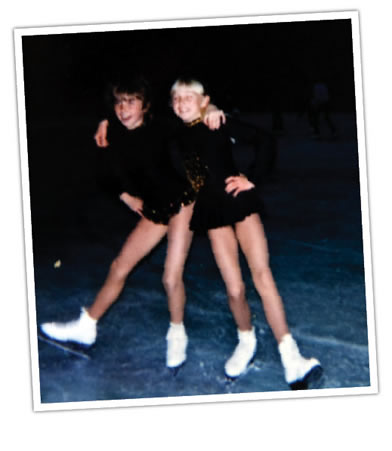 |
| Heidi (left) with a skating friend at the Iceland Rink in Footscray, Melbourne |
| |
How old were you when you first started skating competitively?
I’m guessing I would have been around nine or ten years old, and I think it was a club event at Iceland Footscray which became my home rink after St.Mortiz closed.
At what point did you become serious about competitive skating?
I was competitive from the beginning because my mother was a competitive person. Having been a ballerina herself, she knew what it took to be good at sport.
How many hours a week did you train?
This changed depending on where I was living at the time and what ice time was available to me. When I was living in Bendigo, for example, I was able to get in a practice session in the morning and one again in the afternoon, around six hours a day.
I used to aim to do this six days a week, around 36 hours a week. I also did correspondence school, so I was able to train more and work my studies around that. Compulsory figures took up a lot of time. So, I think time spent on the ice was even longer, an hour to two hours a day extra when we were still doing those.
Who were your coaches?
Factors such as rinks closing and having to move to get decent ice time has resulted in me working with many coaches during my skating career. Each coach has their own unique style of coaching and whilst it might be perfect for some people, might not be exactly right for you. It is really important to find the right coach you can bond with to make the experience an enriching and rewarding experience.
The first coach I really felt close to though was Liz Fell at Iceland Footscray. Liz was my coach until she moved to New South Wales to live; I was devastated. Other coaches I really enjoyed working with along the way and highly respect include Magda Meyer, Trevor Bussey, Wayne Caldwell, Gretchen Doolan (whom I lived with at the time), Reg Park and Belinda Noonan. I was also very fortunate to work with Andrei and Galina Pashin when they first came out to Australia. They are sensational coaches and I feel I gained a lot and improved immensely as a skater whilst learning from them.
Did you contribute to your choreography and musical selections? Did you have any preferences for the music you skated to?
I used to attempt choreographing my programs from a very young age, I enjoyed movement to music and always had a flair for it. Sometimes I would choreograph my own programs other times the coach would do it, it depended on the coach I had at the time, some coaches encouraged it whilst others were very particular about the style of the program and how they envisaged it to be. When I was younger the music was chosen for me, from about 15 years of age I used to source my own. I have a broad taste in music so enjoyed skating to many different pieces.
Did you do any off - ice training? If so, what was it?
From about the age of 13 I supplemented my on ice training with ballet, jogging, aerobics and weight training. From a very young age though, mum encouraged me to practice my elements off the ice. I remember as a child, standing in the back yard doing axels, and holding the clothes line going up and down on one leg in a sit and spiral position.
Andrei and Galina were the first coaches I had that took off - ice training to another level. They taught me strengthening and stretching exercises that were very specific to figure skating, and helped me improve immensely. Off - ice teaches body control and awareness, improves strength and flexibility and can give students an opportunity to achieve elements off the ice in preparation for on ice attempts. I believe all skaters can benefit from off ice training.
How did you prepare yourself psychologically for a skating performance? How aware were you of what your competitors were doing, if at all? Or did you concentrate on what you needed to do instead?
I used to get very nervous before competing. To calm my nerves, I would play my music on my headphones and visualize myself doing the perfect routine in my head. Unfortunately when I was younger, it was often mentioned to me what others were doing, how such and such had this jump and you need to get it and so and so forth. So this did result in me, at that time, focusing too much on what others were doing.
I’m not sure if a sports psychologist educated me or I just matured enough to finally realize that it was pointless to worry about things that are out of your control, such as what other competitors are doing. When I stopped worrying about what others were doing, then I was able to fully focus on the things I needed to do to be a better skater. Basically you skate how you practice. I discovered that if I was well prepared beforehand, fit and ready, then I had a lot less to be nervous about.
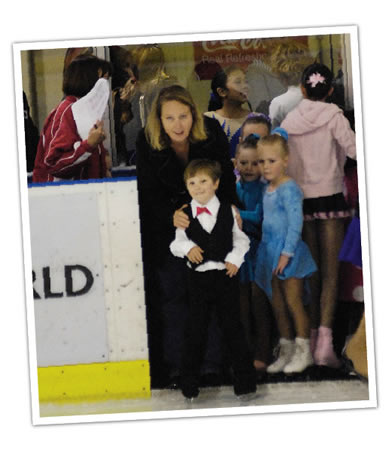 |
Heidi shown coaching her son, Ashley, at a competition |
| |
What is your favorite skating memory?
A highlight for me was my son's first skating competition at age four, seeing him go out there and enjoy performing, watching him skate with the biggest grin on his face.
What was it like to skate at St.Moritz rink in St.Kilda? How aware were you of its history and place in the sport? When the rink closed where did you got to train from there?
St.Moritz will always have a special place in my heart. I grew up in the St.Kilda area, and spent a lot of time at that ice rink when I was a little girl.
I still have dreams about it, the beautiful marble staircase entry, the second floor area overlooking the ice surface, the dome orchestra pit, the large clock at the far end of the rink and the skating lady neon sign. The rink was already very run down by the time I started skating there, but even so you could still feel its magic and its history. It was very sad the day I saw Whelan the Wrecker come to gut it, and even sadder when it caught fire because I believe the Heritage people were trying to save it at the time. I think about it every time I walk down the Esplanade in St.Kilda, about the loss of that beautiful art deco building, and the many happy times people had skating there.
What is your proudest competitive moment or skating accomplishment?
(My proudest accomplishment was) going overseas to represent Australia in Senior ladies at an international competition and passing my final free skating test, which was test nine in those days.
What were the transitions like from Primary to Novice – Novice to Junior and Junior to Senior level?
Skating when you're young is really exciting. You have no fear; everything is right there in front of you. I had very springy jumps, and I was fast. The nickname given to me around the rink was “The Flash”. I was Primary Australian Champion in 1985 and Novice Australian Champion in 1987, so I had a great start.
Injuries were a bit of a problem during my junior years. I was State Champion but just missed out on the medals at Nationals. In those days everything depended on Nationals. If you didn’t get a place at Nationals, you didn’t get international selection. In 1990 I was skating really well, winning both the Hollins and Olympic Trophies. But at Nationals, I had some ankle problems that resulted in me having two ankle operations later that year. I ended up missing a season, and came back in 1992 to gain third place at Nationals in Senior and selection for an international competition.
The hardest part of being in Junior and Senior was that you sometimes felt as if you were with your coach battling it out on you own. I think now days they are supporting our elite skaters more.
We recently had a seminar with ISA (Ice Skating Australia) at the Hunter Ice Skating Club, where I am a coach now. They talked a lot about working together more as a team with other coaches and in squads to help advance potential future champions. I think this is an exciting and positive step for figure skating here in Australia.
Did you have any idols in the sport? If so, who were they and why?
I really love the style, grace and power of skaters like Caryn Kadavy from the USA, Carolina Kostner of Italy and Stephane Lambiel of Switzerland. Also, Australian skaters that were skating before and around the same time as me like Robyn and Sharon Burley, Billy Schober, Cameron Medhurst and Steven and Danielle Carr inspired me and were homegrown skaters that I looked up to. (As a youngster, Heidi added that she also idolised the great American champion, Elaine Zayak.)
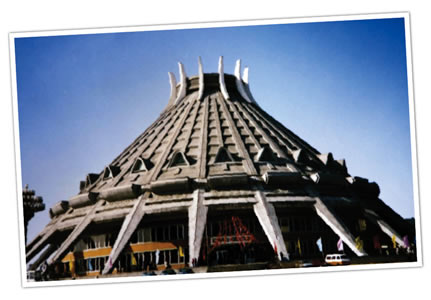 |
| Outside the skating arena in North Korea |
| |
Tell us about your skating experience in North Korea? What was the name of the competition? Which countries were represented? How friendly was the host nation?
We competed in North Korea in 1993. I feel so privileged to have visited North Korea because not many people have the opportunity to go there. People are always surprised when I say I’ve been to North Korea. Sometimes they just don’t believe it and say “don’t you mean South Korea”?
The name of the competition was the Paektusan Prize. Australia had a team of three skaters. I skated in Senior ladies. Jane Rolek from Queensland was in Junior ladies, and Nathan Harrison from New South Wales skated in Junior men. Paul Huengard was our team coach.
The team almost didn’t make it to the competition, because we needed to get our entry visas from the North Korean Embassy in Beijing. But, when we got there, the Embassy was closed down for the hour for lunch. Our plane was leaving within the hour, and there were only two flights to Pyongyang a week. If we missed this flight, then we were going to miss the competition.
We couldn’t believe it. We had come all this way and it looked like we weren’t even going to get to skate. So, we went to the Australian Embassy; the officials there were very helpful.
They gave us lodgings at their own homes, and took us around Beijing while they sorted out our dilemma. The little interlude resulted in us getting to see Tiannamen Square and the Forbidden City, which was a bonus.
The Australian Embassy were life savers. Somehow, they got us seats on a special flight in. The only passengers were North Korean military and us, and we finally made it to North Korea.
We flew into North Korea at night; out the window it was pitch black. I wondered where the city lights were? Later, I found out that they turned off all their city lights at night (I believe for fear of attack?)
At the airport there was massive pictures of their leader at the time, Kim ll Sung and his son Kim Jong ll (the current leader) overlooking the airport. This was to be a common occurrence right around the city everywhere you went. Huge monuments, statues and paintings graced the city. Even in the ice skating stadium their pictures overlooked the rink. Also, every citizen their wears a picture of their leader pinned to their clothing.
The city itself had amazing architecture.
It was somewhat a façade though, because when you entered the buildings, they were very basic. A visit to the local shopping centre was dissapointing. (There was) not much there at all, limited food and very few products for sale.
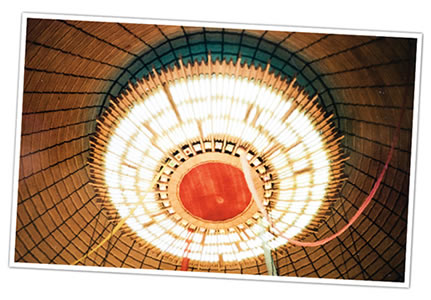 |
The spectacular ice rink ceiling in North Korea |
| |
The ice skating rink was spectacular.
The ceiling looked like a scene out of Close Encounters of The Third Kind, when the giant space ship comes down from the sky. I was so impressed by it that I leaned back to take a photo of it, much to the amusement of the locals who laughed when I took the snap.
Many people came to watch the event, but the majority of audience members were from the military. Countries competing included Russia, France, Spain, Switzerland, Austria, North Korea and others. But, I believe South Korea and America were not invited.
When we were there they were preparing for Kim Jong ll’s birthday celebrations. So there were many marches and parades that the whole community were involved in; you could see them practicing in the square. Unfortunately, we had to leave before the official celebration which from memory, I think they weren’t too pleased about.
The competition was very strong and a real eye opener.
I skated really well, a personal best performance that I am proud of. When I came home I was more enthusiastic than ever. But an off ice accident injuring my knee in the lead up to the state championships put me off the ice, and I didn’t feel I could make another come back again, I had already come back after two ankle operations a couple of years before. That, and the financial strain were major factors in my retirement from competing.
Where else has skating taken you?
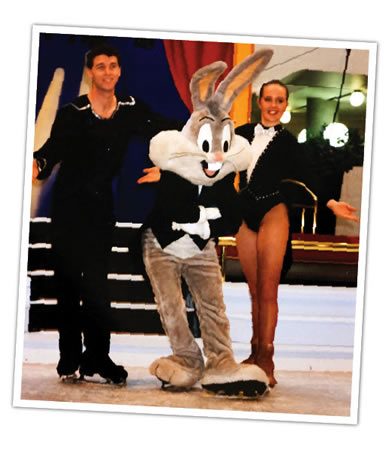 |
Heidi with fellow Victorian skater, Brian Duckworth, and friend, during an ice show performance |
| |
(I was) selected to train at the Australian Institute of Sport, (and a) performer in various ice shows.
More recently in December 2007, we moved to Newcastle so I could take up a full time coaching position at the Hunter Ice skating Stadium. Skating has opened doors for me in many ways. My skating achievements helped me get into University where I completed a Bachelor of Arts Recreation Management Degree. It’s always been a bonus at job interviews too. It’s unique and sets you apart from others. It also shows that all through your life you are the kind of person that is committed to setting objectives, and goals and completing them.
What factors steered you towards coaching? What are some of the key points you tell your students?
I have been part - time coaching on and off ever since I stopped competing. I have always enjoyed developing student's talents. Seeing them finally achieve elements that you have taught them gives great satisfaction.
I recommend that skaters have goals and objectives to work towards in their skating. How high they aim is dependent on their drive and commitment. Sometimes to master certain elements will often take many long hours of dedication and commitment by the skater and their family, and everyone progresses at a different pace.
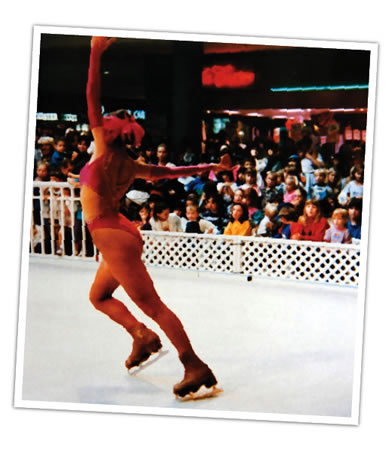 |
| Skating in an ice show at Southland Shopping Centre |
| |
I encourage my students to stay positive when they are struggling with an element. I like to use a lot of positive reinforcement when teaching so the student feels validated and appreciated for their efforts no matter how small.
I tell my skaters to be true to themselves; how you practice influences how you perform. Do complete run - throughs of your program with ALL the elements. Work on your aerobic and anaerobic fitness to be fitter for skating. Stretch to increase flexibility. Warm - up and warm - down to reduce injuries. Practice all your elements; Even the one’s you DON’T like.
Do these things and you will improve as a skater.
What was it like to coach skaters in Taiwan? How different are skaters from Australian students.
It was a brand new rink. The students in Taiwan were very respectful .There was a bit of a language barrier. We picked up a bit of Mandarin and some students knew a bit of English. We had to do a fair amount of demonstrating though to compensate for our lack of words.
To promote the skate school we also had to perform routines for the public. We lived across the road and sometimes rink management would ring up and say “ Busy session on. You come and perform now” So, we would have to drop everything, and gear ourselves up for a performance without much notice.
Once I got over the culture shock of living in such a different environment, I really enjoyed the lifestyle and the people there were lovely to us. Linda Peterson (Aubrucht) and Heidi Kuffell were also coaching there at the time.
What are your thoughts on the present judging system vs the 6.0 format?
It is a lot easier now to understand where the judges are coming from because the individual scores for every element in a skater's performance are now there for the skater to see. In the 6.0 system you just had to accept the marks you were given without any real explanation as to why they were given.
The new system rewards clean skating, so skaters (particularly in the lower divisions) are skating safer to win and not taking as many risks as they used to with the 6.0 system.
For example, good clean singles are worth more than not quite clean double jump attempts. So people are electing to do the singles instead; even though they probably could make decent attempts at the doubles.
It was more about the jumps in the 6.0 system. If you didn’t do the jumps you didn’t win. Spins, steps and spirals are now equally as important as the jumps. The new system also gives credit and increased value for completing things like interesting spin positions, change of edge spirals and more difficult entries into jumps than it did before. As a result skating has improved immensely in this area but the jumping has been compromised.
Until the new dual rink facility opens at Docklands, how different is Victorian skating now from when you competed?
When I started skating in Victoria there were ice skating rinks scattered all over the state, and figure skating was very strong. It was an exciting time, and there was plenty of competition to push you along. Once the rinks started closing however, many people dropped out of the sport and the remaining enthusiasts were forced to train in overcrowded facilities with limited ice time.
At first I would drive up and down to Bendigo, a two and a half hour drive each way, to obtain extra ice time. I eventually moved to Canterbury (NSW), and then later again to Bendigo to live so I could train properly.
Victorians have been waiting for a very long time for a skating rink like the Icehouse facility to come to fruition. There have been numerous rumors and plans for many ice rinks in Melbourne over the years including one at Victoria University and another in St.Kilda but they never eventuated. In the end, we all kept saying “I’ll believe it when I’m standing on it”. I myself kept coaching at various small rinks around Melbourne on a part - time basis because I love the sport. But in the end a great opportunity to coach full time presented itself to me at Hunter Ice Skating Stadium in Newcastle, so I took it. The Docklands Stadium is going to be great for Victorian and Australian skating as a whole and I can’t wait to see it, skate on it and have skaters compete on it.
Do you have any words for kids out there who are considering taking up skating as an after school hobby or competitive sport.
Skating is a unique sport in that it combines athleticism with grace. There is such a variety of elements and skills to learn that it never gets boring, and there is always something new you can try to further challenge yourself.
In Australia, skating is sport and recreation. You can if you wish, pursue it to the highest level, or you can do it on a more social level. I teach many different levels of skating and enjoy all of them. I have skaters ranging in age from 2 years old to 75 years young. Anyone wishing to try it out should look up their nearest rink and get on and give it a try.
Be warned. Once you get into it, is very addictive. |
